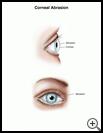
Corneal Abrasion
________________________________________________________________________
KEY POINTS
- A corneal abrasion is a scratch on the clear outer layer on the front of your eye.
- Treatment may include eye drops or ointment. If you wear contact lenses, your eye care provider may ask you to wait one week or longer after your cornea has healed before you wear your contact lenses again.
________________________________________________________________________
What is a corneal abrasion?
A corneal abrasion is a scratch on the surface of the cornea, which is the clear outer layer on the front of your eye. Corneal abrasions are usually very painful.
Most corneal abrasions heal in a day or two. Some abrasions will take longer to heal.
What is the cause?
Corneal abrasions can be caused by:
- Getting poked or hit in your eye
- Getting scratched in your eye with any object such as a fingernail, comb, or twig
- Getting something in your eye such as a splinter, dirt, or eye makeup
- Chipped or cracked contact lenses, or wearing lenses too long
- Certain eye diseases such as corneal epithelial dystrophies
What are the symptoms?
Symptoms may include:
- Redness, pain, and watery eyes
- A scratchy feeling or feeling like there is something in your eye
- Painful sensitivity to light
- Blurry vision
- Eyelid spasms
How is it diagnosed?
Your child’s eye care provider will ask about your child’s symptoms and activities and examine your child’s eye. Using eye drops and a light that makes an abrasion easier to see, the provider will look at your child’s eye. The drops contain a dye that will make your child’s vision and tears yellow for a few minutes. Your child may also have some yellow discharge from the nose for a few minutes after this test.
How is it treated?
If something is still in the eye, your child’s provider will remove it.
Your child’s eye care provider may:
- Give your child antibiotic drops or ointment to prevent an infection.
- Give your child eye drops or ointment to help lubricate the eye to relieve pain.
- If your child also has eyelid spasms, or severe sensitivity to light, your provider may give your child eye drops that dilate your child’s pupil, which relaxes the muscles in the eye and reduces pain.
- Place a contact lens bandage over your child’s cornea. The bandage helps to speed up healing and reduces eye pain.
If your child wears contact lenses, your eye care provider may suggest waiting one week or longer after the cornea has healed before your child wears contact lenses again.
How can I take care of my child?
Follow the full course of treatment your eye care provider prescribes. Ask your eye care provider:
- How long it will take to recover
- If there are activities your child should avoid and when your child can return to normal activities
- How to take care of your child at home
- What symptoms or problems you should watch for and what to do if your child has them
Make sure you know when your child should come back for a checkup. Keep all appointments for provider visits or tests.
How can I help prevent a corneal abrasion?
- Once your child has had a corneal abrasion, your child is at risk for a repeat abrasion in the same area. It may help to use artificial tears or eye ointment to lubricate the eyes well after an abrasion has healed.
- To help prevent severe eye injuries, make sure that your child wears safety eyewear when your child:
- Uses sharp objects or tools, or is around chemicals or splatter of any kind
- Plays sports such as paintball, racquetball, lacrosse, hockey, baseball, and fast-pitch softball
- Follow your eye care provider's instructions for wearing and caring for contact lenses. Do not let your child wear contacts longer than recommended.
Last modified: 2019-07-16
Last reviewed: 2019-07-15

